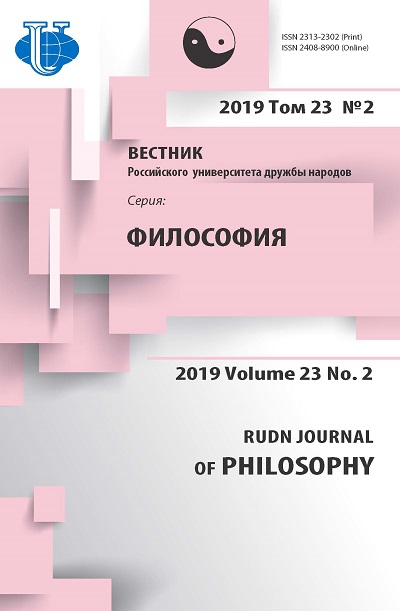MYTHOLOGY AND THEOLOGY. Second Article
- Authors: Naydysh V.M.1
-
Affiliations:
- Peoples’ Friendship University of Russia (RUDN University)
- Issue: Vol 23, No 2 (2019)
- Pages: 210-221
- Section: PHILOSOPHY OF MYTHOLOGY
- URL: https://journals.rudn.ru/philosophy/article/view/21508
- DOI: https://doi.org/10.22363/2313-2302-2019-23-2-210-221
- ID: 21508
Cite item
Full Text
Abstract
The concept of interpretation (as a procedure for determining the values of those abstractions that are used in the theorization of knowledge, in the process of developing an abstract model of the subject) is applicable to any forms of knowledge, including systems of religious knowledge, designing the ideal model of the subject of religious veneration. The author analyzes the epistemological features of theology as a form of spiritual culture, its formation in ancient culture. It is shown that the epistemological basis for overcoming mythological consciousness was the decentralization of thinking, i.e. development of the ability of consciousness in the construction of the image, the picture of the world to correct the position of the subject, to take into account the relativity of the reference system, from the standpoint of which the subject perceives the object and transforms it into an operational system of thinking. Decentration of thinking provided the overcoming of the subjective mental boundaries of the field, giving the thinking nature of universality. Historical stages and moments of this process - the transformation of mythology into forms of folk art, mythopoetic epic, in the form of religious consciousness. In line with such transformations of archaic consciousness, cultural and historical prerequisites of theology emergence were formed. They are represented in mythopoetic art (Homer, Hesiod, etc.), ancient mythography, early traditions of critical and rationalistic interpretation of the myth, etc. The article shows the formation of allegorical theology, which became possible in the era of individualization of artistic creativity, when the visible was the difference between the motive and the purpose of activity, creative idea and its embodiment, figuratively-poetic and rationally-conceptual ways of reflecting the world, when the image of reality and its personal meaning began to be realized as different States of consciousness. The main function of any theology is the interpretation of abstract models of the subject of religious veneration (the imaginary image of the supernatural).
Keywords
About the authors
V. M. Naydysh
Peoples’ Friendship University of Russia (RUDN University)
Author for correspondence.
Email: v.naidysh@bk.ru
доктор философских наук, профессор, профессор кафедры онтологии и теории познания Российского университета дружбы народов
Miklukho-Maklaya St., 6, Moscow, Russia, 117198References
- Aurelius Augustinus. The City of God. Vol. 3. (Gh. 1-Х111). St. Petersburg; 1998. (In Russ.).
- Akimova LI. Iskusstvo drevney Grecii: Geometrika. Arhaika. St. Petersburg; 2007. (In Russ.).
- Homer. Iliad. Trans. by Veresaev. Moscow—Leningrad; 1949. (In Russ.).
- Guseynov GCh. Tipologia antichnoy mifogrsfii. Antichnay poetica. Moscow; 1981. (In Russ.).
- Dvoreckiy IH. Drevnegrechesco-russkiy slovar. Vol. 2. Moscow; 1958. (In Russ.).
- Zelinskiy FF. Ellinskay religia. Minsk; 2003. (In Russ.).
- Losev AF. Homer. Moscow; 2006. (In Russ.).
- Losev AF. Istoria antichnoy estetiki. Vol. 1. Moscow; 1963. (Losev AF. The Dialectic of Artistic Form. Transl., annot. and introd. by OV Bychkov; ed. by DL Tate. München, Berlin, Washington: Verl. Otto Sagner; 2013).
- Naydysh VM. Filosofia mifologii. Ot antichnosti do epohi romantizma. Moscow; 2002. (In Russ.).
- Naydysh VM. Nauka drevneyshih civilizaciy. Filosofskiy analiz. Moscow; 2012. (In Russ.).
- Naydysh VM. Mythology and theology. First article. RUDN Journal of Philosophy. 2017;21 (2).
- Semushkin AV. U istokov evropeyskoy razionslnosty. Moscow; 1996. (In Russ.).
- Paul Tillich. Systematic theology. Vol. l—2. Moscow, St. Petersburg; 2000. (In Russ.).
- Fragmenty rannih grecheskih filosofov. Vol. 1. Moscow; 1989. (In Russ.).
- Formen und Funktionen der Allegorie. Hrsg. W. Haug. Stuttgart; 1979.
- Grammatica Latina. Vol. 1. Leipzig; 1857.
Supplementary files















